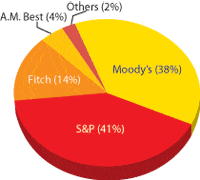With a global reach but only three primary players, the powerful credit-rating business may finally be getting an overhaul and some new competitors.
By the end of March the US Securities and Exchange Commission will put out a concept release that will investigate everything from conflicts of interest between the agencies and the corporations whose debt they rate to the red tape that now hinders the entry of new players. The SECs next step will be absorbing comments on the concept release and then issuing proposed rules that will address the issues affecting the controversial credit-rating business.
Credit rating agencies are supposed to be unbiased. But the dynamics of the situation cut against full objectivity, says Raphael Russo, an attorney and partner in the corporate department at Paul, Weiss, Rifkind, Wharton & Garrison in New York. Russo was referring to the fact that the corporations pay for the credit ratings provided by the credit agencies. Theres also a limited amount of companies that do it, he notes.

|
|
|
The domination of the industry by three agenciesMoodys Investors Service, Standard & Poors and Fitch Ratings (which, while based in the United States, is owned by the French financial group Fimalac)has generated increasing controversy in the financial industry over the past year. Critics argue that the ratings agencies did not adequately warn investors of the impending failures of Enron, WorldCom and other companies that rocked international financial markets. They argue that increased competition could keep everybody on their toes.
One section of the Sarbanes-Oxley Actthe US Congress response to the financial scandalsdirects the SEC to look at the role and function of credit rating agencies in the operation of the securities markets. The SEC report, released in late January, coincided with a review of credit rating agencies already under way at the commission.
One issue now being investigated by the SEC is expanding the number of companies allowed to serve as nationally recognized statistical rating organizations, also known as NRSROs. While other, smaller agencies provide similar services to the financial markets, Moodys, S&P; and Fitch have been the only agencies carrying the coveted NRSRO designation since 1992. There is no pan-European agency, and Japan has some domestic rating agencies that carry little weight with international investors. And its vital to receive the SEC designation as an NRSRO because many corporationsas well as state and local governmentsrequire investment managers to use credit rating agencies that have the NRSRO label. Yet up to now it has been difficult for the small rating agencies to break the entry barrier.
A survey conducted last fall by the US-based Association for Financial Professionals showed that 90% of the treasury and financial professionals who responded believe the SEC should move to improve its oversight of the rating agencies and foster greater competition. The survey indicates that financial professionals believe more competition in the ratings industry will boost the accuracy and timeliness of the credit ratings and ultimately lead to greater certainty in how corporate risk is assessed.
Theres a belief that because there are so few agencies, the lack of competition may be the underlying cause of the inaccuracy and lack of timeliness [of ratings], says Jeff Glenzer, director of treasury services at the association, located in Bethesda, Maryland.
A.M. Best, an agency that now rates the debt of insurance companies, has been encouraged enough by the SEC process to submit an application for recognition as an NRSRO. We want to extend our expertise in the insurance industry, says an A.M.Best spokesperson. As Global Finance went to press, Dominion Bond Rating Services, a private Canadian company, received the coveted NRSROdesignation from the SEC after a three year wait.
Paula L. Green



